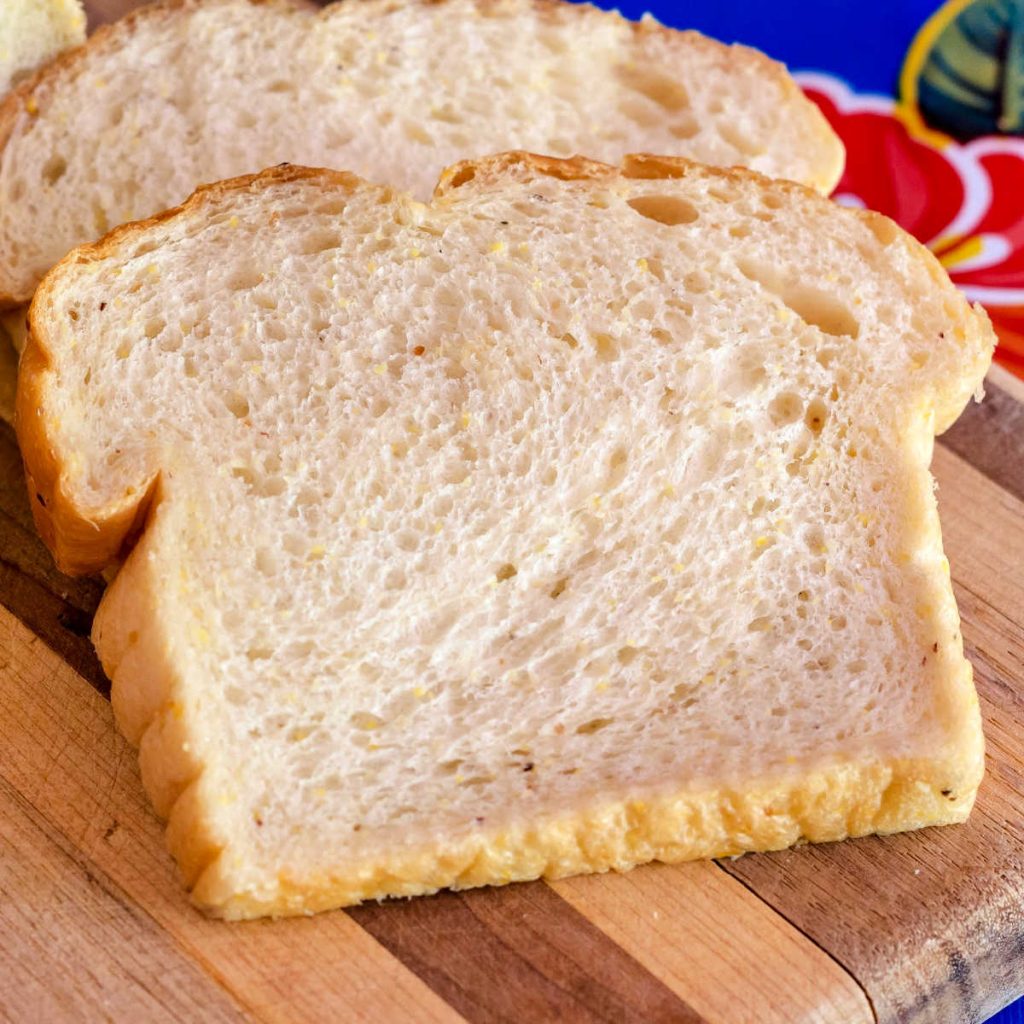This post is all about what yeast does in baking. We’re specifically talking about bread yeast, but all yeast pretty much do the same thing. It’s just that some yeast has been bred to work best in breads.
Read this for a good discussion of using beer yeast in baking. You may also be interested in my master post on Ingredient Function.
This post is part of my Baking Basics series where I tackle readers’ baking and cooking questions. Thanks for reading!
Pastry Chef Online Participates in Affiliate Programs. If you make a purchase through one of my links, I may earn a small commission. For more information click to read my disclosure policy

What Is Yeast?
Yeast are single-celled little fungi.
Yeast live to eat sugar, make alcohol and produce gas. Oh, and reproduce.
And that’s pretty much their whole raison d’etre.
Important Things to Know
Please don’t be intimidated by yeast. They are much smaller than you, and you have opposable thumbs and a forebrain. You are smarter than yeast, so fear not!
There are a couple of Things to Know about yeast:
1)Like people, yeast doesn’t like to be too hot or too cold. If they get too cold, they just lie there, dormant and hibernating. If they get too hot, they die. Either way, your rise won’t happen unless the yeast are in their temperature comfort zone.
Fortunately, yeast’s comfort zone is kind of like our comfort zone. They’ll perform nicely at around body temperature. At temperatures abovoe 140 degrees, F, they die. At refrigeration temperatures, they fall asleep. You can adjust rising times by manipulating the temperature of the dough, but I’m getting ahead of myself.
2)The power that yeast has to make liquids ferment and doughs rise has been harnessed for thousands of years. There is always some sort of yeast hanging out in the environment around us. Capturing and taming wild yeast gives us sourdough starters and breads.
Commercial yeast is much less dicey to deal with–you always know what you are getting.
3)Yeast like it best in environments whose pH is neutral or just slightly acidic. Too much acid, and they won’t grow. Too much alkali, and they won’t grow. This is generally not a problem in baking since most yeast dough recipes fit yeast’s preferred pH profile. No surprise there.
Jenni Says: If the environment is cozy for you, it’ll be cozy for yeast. Use warm–not hot– liquids (unless you’re going for a slow rise).
What Does Proofing Mean?
Proofing yeast just means mixing it in some warm water so it can start getting bubbly and PROVE to you that it’s alive.
Seriously, that’s all it means.
If you’re going to proof your yeast before continuing with your recipe, toss in just a teaspoon or so of sugar or honey with the warm water.
This will make the yeast happy as they will have something to snack on so they can prove to you they’re alive.
Is There Some Sort of Mysterious Secret About Making Bread?
Not so much. If there is a secret, it’s to relax.
In almost all cases, use a high protein flour–either a very sturdy all-purpose flour, such as King Arthur, or bread flour.
Always put salt in bread. Always.
Not only will it make your bread taste good, it also helps to control yeast growth and keep your crumb a little tighter.
What Is Fermentation?
Fermentation occurs when our yeast friends convert sugar into three things:
- alcohol
- carbon dioxide
- heat
Fermentation occurs anaerobically, which means not in the presence of oxygen.
That’s about as deep into the chemical process as I am able to want to go, but note this: one of the by-products of fermentation is heat.
PRO TIP: Refrigerate your dough to slow down the fermentation process. Refrigeration to slow fermentation, called a retard (reh-TARD), also can yield a more flavorful dough and final bread.
Admittedly, this little primer just scratches the surface of what yeast does/can do. If you have a specific question, don’t hesitate to ask.
Quick Recap
- Don’t be afraid of the yeast.
- Keep the yeast at a comfortable temperature. You know, so it won’t DIE.
- Use high-protein flour.
- Yeast lives to turn sugar into alcohol+carbon dioxide+heat.
Types of Yeast
There are about 1500 different kinds of yeast. That’s a Very Lot. Not all of them are the kinds that we want in our bread or our beer, though.
Here’s the kind we like: Saccharomyces cerevisiae Look at those words for a second–I see “sugar” and “beer.”
Those crafty yeast-namers!
S.cerevisiae eats sugar to make alcohol. Perfect!
How Did Leavened Bread First Happen?
Nobody really knows when people started actively using yeast to leaven their bread.
There are records of bakeries back in ancient Egypt, but nobody can really pinpoint the date. Best guess–about 5000 years ago.
How It Probably Happened: By Accident
Mr. Retehtey (Egyptian for ‘baker’–see, I do my research) mixed his flour and water as usual.
Then, his wife called to remind him of the parent-teacher conference (okay, not too much research). Since family duties take precedence over bakerly duties, off Mr. Retehtey went to the conference.
We shan’t eavesdrop there, but suffice to say, it was a long conference.
When he returned to his dough, he noticed that it was puffy and smelled interesting. Not bad–actually, it smelled pretty good.
With a shrug and a quick prayer, Mr. Retehtey baked his dough, and what came out was remarkable! Puffy, sproingy, golden brown, chewy bread. Yay for you, Mr. Retehtey!
Would you like to save this post?
So, What Happened?
Setting out the flour and water was an open invitation for yeast to jump in and chow down.
Happily for Mr. Retehtey, and for us, old S. Cerevisiae, or a close cousin, showed up.
Sourdough: An Aside
These days, there are a couple of options for replicating Mr. Retehtey’s feat.
You can harness your own wild yeast and hope for the best, or you can buy a (affiliate link) sourdough starter (a mix of several strains of wild, tasty yeast that provide a tangy, slightly sour flavor profile).
Sourdoughs are not my forte, so I won’t even try and pretend to be The Expert.
There are plenty of sites out in the vast Hinternet that can help you with sourdough. The Fresh Loaf is an excellent resource for information on all things bread, sourdough or otherwise.
Fresh Yeast Vs. Dry Yeast
I have much more experience using fresh and packaged dry yeast.
Fresh yeast is sold in compressed cakes. It is soft, somewhat sticky, and highly perishable. It can grow moldy really quickly.
If you are using fresh yeast, you must keep it well-wrapped and refrigerated and use it within a week or two.
For that reason, it can be a bit of a pain to use, especially if you don’t bake bread very frequently.
I used it at the restaurants I’ve worked in, but at home, I stick with the dry kind, either active dry or instant yeast.
Active Dry Vs. Instant Yeast
The two most commonly available types of dry yeast are Active Dry and Rapid Rise or Instant Yeast.
Active Dry yeast comes in fairly large granules and generally needs to be dissolved in warm liquid before using.
Rapid Rise/instant yeast is processed into finer particles and was developed to be added along with all the other ingredients–no dissolving required.
In recipes calling for fresh yeast, I usually use 1/3 the amount of dry yeast.
So, if a recipe calls for 1 oz. fresh yeast, I’ll use 1/3 oz (about 9-10 gram) of dry yeast.
PRO TIP: To substitute dry or instant yeast for fresh yeast, use 1/3 the amount by weight. So for 1 oz fresh yeast, use 1/3 oz dry/instant yeast.
Storing Yeast
Store your dry yeast, tightly sealed, in the refrigerator or freezer.
It will last up to a year, so if you’re uncertain, do the proofing trick to make sure your yeasts are still alive and kicking.
How Does Yeast Make Bread Rise?
In traditional wheat flour-based baking, the liquid (water, milk, etc) mixes with the flour. That mixing makes two proteins present in wheat flours, glutenin and gliadin, come together and form gluten, the protein structure that is stretchy and that captures air bubbles to make the dough rise.
And where do those bubbles come from? They come from the fermentation process of yeast eating the carbohydrates present in the dough (sugars from the flour and any added sugar) and then belching out carbon dioxide gas.
As those bubbles try to rise out and into the air, they are captured by the stringy protein matrix of the gluten and then get stuck.
That’s what the crumb structure of the bread is. It’s the holes (tunnels, really), both big and small, where carbon dioxide bubbles used to be as they are trapped in the gluten.
What Happens to the Yeast in the Oven?

Once the yeast has done its thing and helped your bread to rise, and you put your bread dough into the oven, the initial increase in heat provides one last fairly impressive rise called “oven spring.”
This allows your bread to be nice and light. It also signals the last hoorah of the yeast as they die off in the heat of the oven.
What they leave behind is all the bubble tunnels that the carbon dioxide made as well as flavor.
Generally speaking, the longer the rising takes, and especially if you do a retard in the fridge for a night, the more flavor your finished bread will have.
Yeast Bread Recipes to Enjoy
Now that you know what yeast is, how it behaves, and what it does to bread dough, it’s time to put that knowledge to use and make some bread.
One of my favorite basic bread recipes on the site is my potato sandwich bread. It bakes up soft and pillowy, and is a great white sandwich loaf that also makes great toast.
While the potato bread replaces a certain percentage of flour with a starch (starchy potatoes), the Tangzhong method of making bread takes a portion of the flour in the recipe and cooks it together with a portion of the liquid until the starches in the flour gelatinize.
I make my milk bread using the Tangzhong method. And my Cornish saffron bread is an enriched version of Tangzhong-method bread.
For more bread recipes, check out both my bread and roll recipe category as well as my sweet yeast bread category.
Want More Posts Like This?
While you’re here, I’d love it if you’d sign up for my newsletter. If having me occasionally pop into your inbox sounds like a plan to you, here’s how to sign up!

Hi, y’all! I hope you’ve enjoyed this post and hopefully also learned a thing or two.
If you like my style, I invite you to sign up for my occasional newsletter, The Inbox Pastry Chef.
Expect updates on new and tasty recipes as well as a bit of behind-the-scenes action. I hope to see you there!
Questions?
If you have any questions about this post or recipe, I am happy to help.
Simply leave a comment here and I will get back to you soon. I also invite you to ask question in my Facebook group, Fearless Kitchen Fun.
If your question is more pressing, please feel free to email me. I should be back in touch ASAP, as long as I’m not asleep.



Join in Today!


This is the simplest, most clear, concise info on yeast I’ve ever seen 🙂 Thank you!
Hooray! Happy to be of help!
Also, be sure the yeast isn’t old.
Question. Let’s say, hypothetically of course, that you fast acting yeast accidentally ended up in the fridge after coming home from the store. Is it still ok to use?
Good question. Stay tuned for your answer on the morrow:)